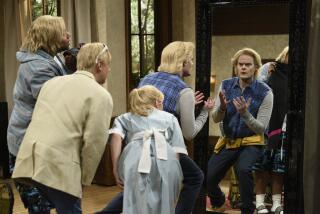It hits us where we laugh
- Share via
Maybe it’s the exposure, the vulnerability or simply a white-hot resentment of men. Whatever it is, few things from Hollywood’s greatest creative minds elicit the crowd-pleasing merriment of watching a grown man take a monster shot to the groin.
Around since antiquity, the assault on a man’s nether region is enjoying a sort of renaissance -- if such a highbrow word can be used in such a lowbrow context -- becoming a virtual staple of the summer comedy as evidenced in such current films as “DodgeBall,” “Napoleon Dynamite,” “White Chicks” and “Anchorman.”
And it’s not just slap-happy times at the movies. TV sitcoms and advertisers frequently capitalize on the visual gag’s comic potency too. Audiences today can’t seem to get enough -- and perhaps they never have and never will.
“It’s been around at least since ancient Rome,” said Amy Richlin, a classics professor at USC who teaches a course on comedy. “There’s something about the things that stick out of the body -- noses, ears, a woman’s [chest] -- that seem to be funny. It’s like bodily fluids, they make people laugh.”
In an age when government figures are routinely seen apologizing for a misinterpreted or off-color joke or offending a delicate sensibility, it’s perhaps odd that no one -- particularly men -- seems terribly upset about the frequent attacks on the most sensitive area of the male anatomy. There’s a good reason for the lack of protest and abundance of laughter, humor scholars say: Men, in society’s eyes, deserve it.
“Women would certainly be screaming and complaining if men were kicking women in the genitals [in popular culture],” said Murray Davis, author of “What’s So Funny: The Comic Conception of Culture and Society.” “But men by and large still hold almost all the positions of power in society, and the powerful are always targets for humor.”
But a perceived injury to the distinctly male body part must be set up with the proper amount of distance, even empathy, to provoke belly laughs instead of painful groans. “DodgeBall,” in which nearly half a dozen men take one for the team, faithfully adheres to this time-honored formula, following in the rich tradition of such classic sports movies as “The Longest Yard” and “The Bad News Bears.”
In an almost cartoonish fashion, either a “bad guy” or a sympathetic minor character tagged for comic relief gets it. In these sequences, men and the opposing objects must collide quickly, preferably with some surprise.
For example, in “DodgeBall,” Rip Torn plays a crusty coach in a wheelchair who’s charged with whipping a bunch of misfits into shape for the “big tournament.” In an effort to teach the team the ropes, Torn hurls ball after ball at a nice but geeky high school kid who catches a few in the groin.
With each wallop, the poor victim registers the obligatory look of shock and pain -- and then it’s immediately on to the next sequence.
Too much authenticity, however, can be deadly. Veteran comedy writer Bill Martin remembers when he was with the now syndicated sitcom “3rd Rock from the Sun,” and in one comic bit had an off-camera man in vice grips deliver a guttural moan.
“It was really, really funny,” Martin said. “But the sound effect was too organic and it killed the joke.”
Today’s writers can probably claim much the same motive for using the prank as the Roman playwright Plautus, known for his comedies of middle- and lower-class life around 200 BC. Plautus made numerous explicit references in his works to the injury men most fear, according to Richlin, who has translated many of the plays from the original Latin. Like many Romans, she added, Plautus believed superstitiously that writing about something would make it less likely to happen.
“They thought that if you laugh at it, you take off the curse,” said Richlin, whose book “Rome and the Mysterious Orient: Three Plays of Plautus,” is due out next year from the University of California Press.
Of course, this doesn’t explain why women -- at least those who can remain in the room while an episode of “The Three Stooges” is airing -- think it’s funny. The action levels a man, literally and sexually, and the joke may be especially effective when the force behind the blow is a woman. In “Anchorman,” an up-and-coming female television reporter gives a workplace sex harasser -- who has just groped her -- his comeuppance with a fist to his private parts.
“When a woman kicks a man, it’s a way for her to temporarily assert her power relative to a man -- in a short, sharp way,” said Davis, a retired sociologist. “It has to be clear the injury is not really terrible, not life-threatening. I mean, if they castrated a man, that wouldn’t be funny.”
A measure of schadenfreude also undergirds a man’s laughter as well. Quite simply, a man is tremendously relieved it isn’t him bent over and bug-eyed.
“It’s well disguised, but there’s still an element of sadism here,” Richlin said. “I’m really a firm believer in the basic tenet of Freud’s theory of humor, which is that it’s grounded in hostility and aggression; the cream pie in the face is a substitute for a punch in the nose.”
Until the mid-1960s, Hollywood had to be largely content with a pie in the face instead of a kick in the groin because of the so-called Hays Code, which regulated matters of decency and taste and probably prevented “The Three Stooges” from doing even more memorable damage to each other. But by the late 1960s, the code became unenforceable, and the floodgates for bawdier brands of humor were opened.
In the ensuing years, the groin gag appeared sporadically in films, including 1969’s “Butch Cassidy and the Sundance Kid,” 1974’s “Young Frankenstein” and 1981’s “Stripes.” In recent years, the audience favorite enjoyed a couple of new twists after 1998’s hit comedy “There’s Something About Mary,” which depicted caught-in-the-zipper and dog-affixed-to-man’s-crotch jokes.
“The Farrelly brothers made the groin new again,” Martin joked.
Within the past couple of years, advertisers have jumped on the bandwagon. More than half a dozen commercials, usually for beer, banks or deodorants, showed a man getting hit by, among other things, a golf ball, a cane or a malfunctioning rapid-fire tennis ball machine.
Last summer, “The Daily Show with Jon Stewart” lampooned the trend by holding a mock “all-star tribute” to the manhood-pounding commercials. After watching a slew of the ads, including one in which an unsuspecting man is hit by a flying bowling ball, host Ed Helms asks: “Wow! What will they think of next?”
Clearly the joke, in one form or another, is here to stay, say comedy writers, most of whom after all are men.
“As long as there are human beings,” said Ben Karlin, executive producer of “The Daily Show with Jon Stewart,” “there will be film depictions of guys getting hit in the testicles. You can put that on my gravestone.”
More to Read
The complete guide to home viewing
Get Screen Gab for everything about the TV shows and streaming movies everyone’s talking about.
You may occasionally receive promotional content from the Los Angeles Times.






